R.C. Venette, W.D. Hutchison, E.C. Burkness, and P.K. O’Rourke
Department of Entomology
1980 Folwell Ave.
University of Minnesota, St. Paul 55108
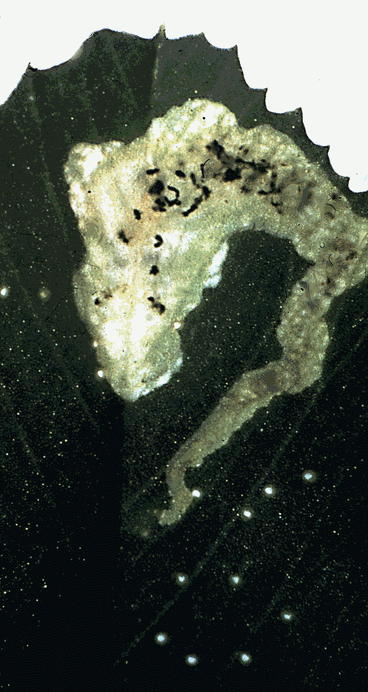
Alfalfa acreage in the upper midwest was recently invaded by the alfalfa blotch leafminer (ABL), Agromyza frontella. ABL is a gnat-like fly (Diptera) from Europe that was first detected in North America, in Massachusetts, in 1968. By 1994, populations of ABL reached northern Minnesota and by 1997 could be found throughout Wisconsin, the northern 2/3 of Minnesota, and the northeastern corner of Illinois. By October, 1998, ABL was distributed throughout Minnesota, Wisconsin, northern Illinois, and eastern North Dakota. To our knowledge, surveys have not been conducted in South Dakota. Surveys for new outbreaks continue to refine predictions of when and where ABL will occur next. Recent assessment of over 80 alfalfa varieties adapted to the midwest, indicate very little resistance to ABL damage. Much of our research is now focused on chemical and biological control strategies that should be compatible with common grower practices.
Background
Previous infestations of ABL in Canada and the northeastern US suggest that this insect may reduce alfalfa yields by 7-20% and protein content by 10-20%. Both adults and larvae damage the plant. Females feed by puncturing leaves with their ovipositors, creating characteristic "pinholes," and consuming plant juices. A single female creates an average of 3,769 pinholes during her lifetime. Larvae emerging from eggs create distinctive mines as they feed (Fig. 1). Within a field, it is not uncommon for 70% or more of the leaflets to be attacked. The wounds also increase the susceptibility of alfalfa to diseases, especially spring black stem. The economic impact of damage caused by ABL is unclear, but the visible damage caused by even low numbers of flies can be disturbing.
Distribution and Spread
By the end of 1998, alfalfa stems damaged by ABL were detected in 69 of 82 (sampled) MN counties, 64 of 68 WI, and 3 of 6 northern IL counties (Fig. 2). These infestations may have resulted from the importation of infested hay from Thunder Bay, Ontario. The Thunder-Bay area was known to be infested in 1991. No evidence of the pest was found in the southern third of MN or in 5 surveyed counties in northeastern IA.
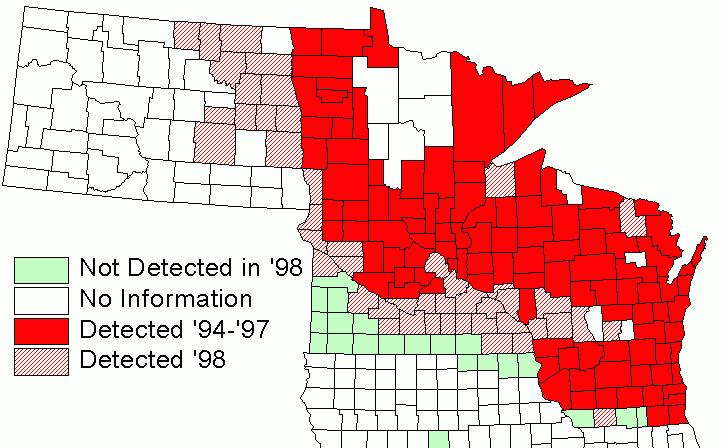
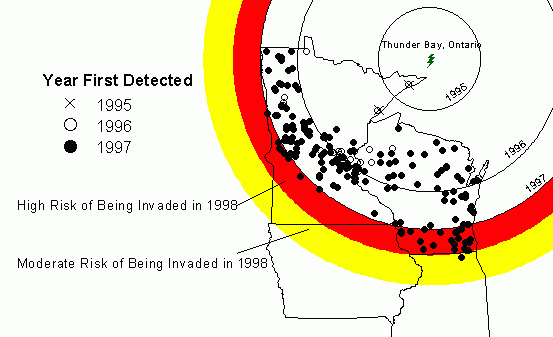
Assuming the invasion started in 1991, we estimate that the rate of spread through MN and WI has averaged 58 mi (93km)/yr (Fig. 3). This rate is slightly faster than the 25-50 mi (40-80 km)/yr reported in the literature. ABL may spread by trucking infested hay, wind dispersal, or adult flight. Assuming spread proceeded at our estimated rate, in 1997 we predicted that ABL damage would be detected throughout MN and WI and into parts of ND, SD, IA, and IL by the end of 1998 (Fig. 2). These predictions have proven to be correct. Several new counties were recorded as infested in 1998 (Fig. 2).
In MN, damage caused by ABL has been most severe in the central part of the state (Fig 4). In WI, the most severe infestations appear to be limited to the northwestern and central counties. Severe infestations appear to lag behind the invasion front by approximately one year. We speculate that damage is most severe where populations have been present for the greatest amount of time. If this assumption is correct, the pattern of severity suggests that ABL is generally spreading from the northeast to the southwest in MN.
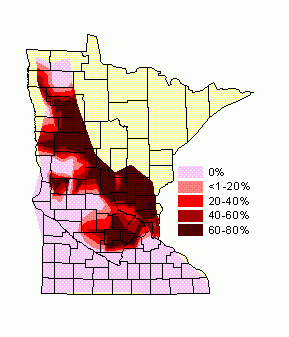
Early-Season Phenology
The amount of damage from ABL depends on the development of the pest population. In 1998, population dynamics of ABL near Anoka, MN were monitored twice a week since the end of April. Adults were collected with a sweepnet and trifoliates were inspected for pinholes and mines. The emergence of adults coincided with the first detection of pinholing. Peak emergence of adults took place on or around May 11th (Fig. 5).
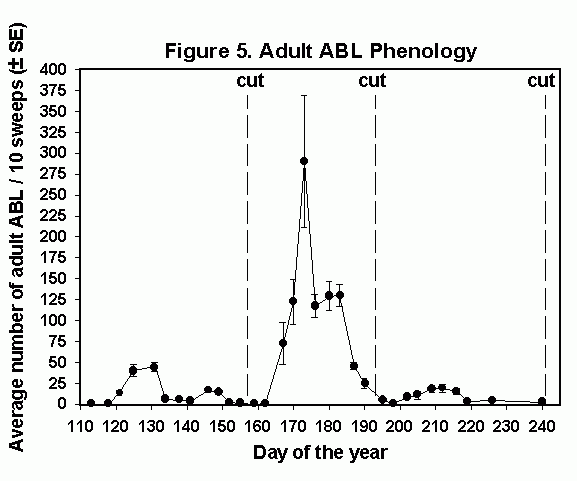
Pinholing was most severe three days later and remained relatively constant at 50% of trifoliates with damage (Fig. 6). Mines, associated with the emergence and feeding of larvae, first appeared on May 14 and peaked on May 21. Subsequently, the percentage of trifoliates with mines remained relatively constant at approximately 20%. Populations of ABL begin to develop when temperatures rise above 40-45°F (4-7°C). Alfalfa also begins to grow between these temperatures. Consequently, the growth of alfalfa and ABL are closely synchronized. In MN, ABL can complete two to four generations during a growing season (Fig. 5), from the northern to the southern regions of the state.

Biological Control
Severe infestations of ABL in the eastern US and Canada are suppressed below economically damaging levels by an introduced parasite, Dacnusa dryas. The parasite was released several times between 1974 and 1978. Within 3-5 years after the establishment of the parasites, D. dryas reduced populations of ABL by 98%. However, as others have observed, ABL appears to be spreading faster than its major parasites. Surveys for D. dryas in MN and Thunder Bay, Ontario have failed to detect the parasite. Other native parasites, including several species of Diglyphus, have been observed in MN, but these species do not provide sufficient levels of control. Releases of D. dryas into MN are currently planned for 1999. Biological control, via D. dryas, appears to be the best long-term management strategy.
Insecticidal Control
While D. dryas is becoming established, insecticides may be the only means to control ABL. Unfortunately, replicated trials including over 80 alfalfa varieties in 1998, indicated no significant levels of resistance to ABL.
In 1997, we conducted two trials to evaluate the degree of control provided by currently labeled insecticides. Sweep counts of adult ABL indicated that control never exceeded 90% compared with the untreated check. Analysis of stems and leaves revealed that several insecticides may reduce the incidence of mining, but none of the materials reduced the incidence of pinholing. Damage was evenly distributed between newer (top half) and older (bottom half) growth. In 1997, the use of insecticides did not significantly improve alfalfa yield or protein content (all insecticides currently labeled for alfalfa). In 1998, Warrior was included in the trial, as well as Pounce and Baythroid (Table 1). To date, of all the insecticides tested, Warrior is the only material that showed a significant impact on yield, an increase of approx. 12% over the untreated check plots. Also in 1998, the use of surfactants did not improve the efficacy of any of the pyrethroid materials. Overall insecticide performance suggests that currently labeled products are not likely to provide consistent control of ABL at typical use rates. Only under severe conditions should a grower consider using an insecticide at this time – and only Warrior should be considered (at 3 to 3.84 fl. oz./ac).
Table 1. Effect of labeled insecticides on adult counts and damage caused by alfalfa blotch leafminer (1998-Anoka Co., MN).
|
Treatment |
Rate (lbs. AI/ac) |
Dry matter, |
Stem Ht. (cm) |
Mean # ABL adults/10 sweeps (% control) 7 DAT |
Mean # ABL adults/10 sweeps (% control) 17 DAT |
% of Trifoliates with Pinholes or Mines 7 DAT |
% of Trifoliates with Pinholes or Mines 17 DAT |
|---|---|---|---|---|---|---|---|
|
Sevin XLR Plus 4E |
1.5 |
0.99 (0) ab |
55.1 AB |
112 (0) A |
32 (0) A |
66.1 AB |
81.8 A |
|
Penncap-M |
0.75 |
1.03 (0) ab |
55.2 AB |
145 (0) A |
30 (0) A |
69.0 AB |
79.6 A |
|
Pounce 3.2E |
0.15 |
1.10 (2.9) ab |
57.4 A |
64 (39) AB |
30 (0) A |
61.1 BC |
77.4 A |
|
Baythroid 2E |
0.044 |
1.05 (0) ab |
53.6 B |
7 (93) B |
38 (0) A |
49.2 CD |
66.9 A |
|
Warrior |
0.03 |
1.21 (12.7) a |
57.8 A |
6 (94) B |
35 (0) A |
41.7 D |
63.3 A |
|
Pounce+Surfactant |
0.15 |
0.86 (0) b |
53.1 B |
73 (30) A |
22 (12) A |
61.6 BC |
80.8 A |
|
Warrior+Surfactant |
0.03 |
0.85 (0) b |
51.5 B |
7 (93) B |
26 (0) A |
42.7 D |
72.5 A |
|
Untreated Check |
-- |
1.07 (0) ab |
51.6 B |
105 (--) A |
25 (--) A |
74.9 A |
82.3 A |
Means followed by the same letter within columns are not significantly different; Ryan-Einot-Gabriel-Welsch multiple F test. (Lower case: a=0.1; Upper case: a=0.05). DAT = Days after treatment
Potential Impact
The potential impact of ABL is significant. Minnesota and Wisconsin produced 10.2 million tons of alfalfa in 1996. A 7% yield loss caused by ABL (estimated in states previously infested by ABL) could result in regionwide economic losses of $75.6 million (assuming an average of 3 tons/acre valued at $100/ton).
However, given the variable yield results to date, it is difficult to assess actual economic impact. Accurate assessments of yield loss require effective control of the pest population. Although insecticides reduced ABL damage in the 1997-1998 trials, damage was not eliminated. The use of silicone surfactants to facilitate the penetration of insecticides into the leaf tissue also did not provide greater control of ABL. To better assess the true economic impact of this insect, trials for 1999 will focus on experimental insecticides, with known leafminer activity, and multiple sprays with selected insecticides currently labeled.
ABL is different from other alfalfa pests in Minnesota in the sense that the pest is relatively new and its invasion of the state is not yet complete. Consequently, many fundamental questions remain unanswered. How is the pest dispersed? From where did the Minnesota populations arrive? The Thunder-Bay hypothesis is one explanation. Alternatively, ABL populations in Minnesota may represent the convergence of two "branches" of the invasion front as they spread around the Great Lakes. Are natural enemies, especially D. dryas, chasing the spread of ABL? How much damage will ABL cause under Minnesota growing conditions? Answers to these questions are critical for the development of effective strategies for the management of A. frontella.
Acknowledgments
We thank Drs. Dave Bartels and Dharma Sreenivasam, Minnesota Department of Agriculture (MDA), the MDA Plant Pest Survey personnel, and the Wisconsin Department of Agriculture, Trade, and Consumer Protection who assisted with the 1997-1998 MN-WI survey for ABL. We also acknowledge the Agricultural Utilization Research Institute (AURI) and the North Central Integrated Pest Management Program for funding various aspects of this study.
References
- Drea, J.J., Jr., and R.M. Hendrickson, Jr. 1986. Analysis of a successful biological control project: the alfalfa blotch leafminer (Diptera: Agromyzidae) in the northeastern United States. Environmental Entomology. 15: 448-455.
- Harcourt, D.G., J.M. Yee, and J.C. Guppy. 1983. Two models for predicting the seasonal occurrence of Agromyza frontella (Diptera: Agromyzidae) in eastern Ontario. Environmental Entomology. 12:1455-1458.
- Hutchison, W.D., P.K. O’Rourke, D.W. Bartels, E.C. Burkness, J.C. Luhman, and J. Heard. 1997. First report of alfalfa blotch leafminer (Diptera: Agromyzidae), and selected parasites (Hymenoptera: Eulophidae) in Minnesota and Wisconsin, USA. The Great Lakes Entomologist. 30:55-60.